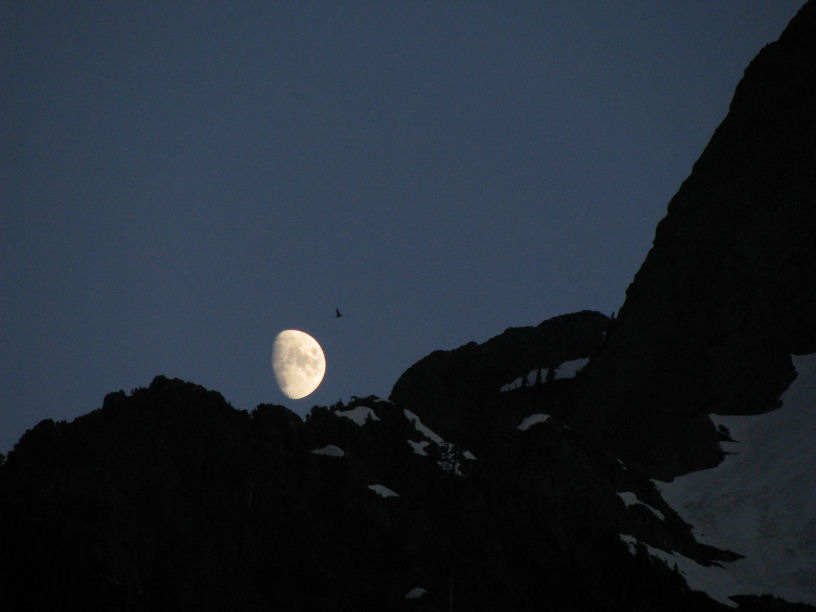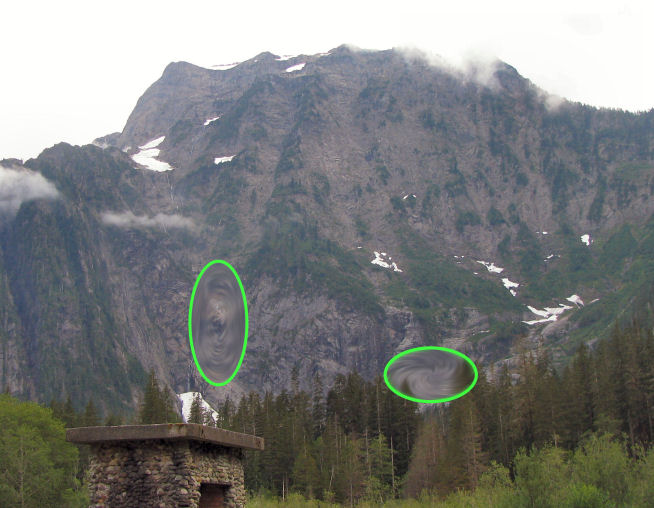Big Four Rocks! EarthCache
-
Difficulty:
-

-
Terrain:
-

Size:  (other)
(other)
Please note Use of geocaching.com services is subject to the terms and conditions
in our disclaimer.
Important:
Please make sure to read the write up for this earthcache and study the lower photo.
It contains important information needed to log this cache.
 Anyone traveling up the Mountain Loop Highway from Granite Falls to this area certainly can’t fail to be awed by Big Four Mountain. It steeply rises over 4000’ feet from its base at 1900’, for an elevation of over 6160’ at its top. In addition to its obvious rugged beauty, a short hike will bring you to the famed Big Four Ice Caves, created from avalanche debris, not glaciers as is popularly believed. Visit Harriet the Spy's earthcache GC1575A - Big Four Ice Caves to learn more about these unusual formations.
Anyone traveling up the Mountain Loop Highway from Granite Falls to this area certainly can’t fail to be awed by Big Four Mountain. It steeply rises over 4000’ feet from its base at 1900’, for an elevation of over 6160’ at its top. In addition to its obvious rugged beauty, a short hike will bring you to the famed Big Four Ice Caves, created from avalanche debris, not glaciers as is popularly believed. Visit Harriet the Spy's earthcache GC1575A - Big Four Ice Caves to learn more about these unusual formations.
 Big Four Mountain is older than the dinosaurs, made primarily of sedimentary materials that were laid down some 260 to 370 million years ago. (The dinosaurs lived some 160 to 65 million years ago!) The well known, iconic volcanoes of Mt. Rainier and Mt. Baker are relatively young compared to Big Four Mountain, at 500,000 years and less than 140,000 years, respectively. (Cascade Volcanoes are less than one million years old.)
Big Four Mountain is older than the dinosaurs, made primarily of sedimentary materials that were laid down some 260 to 370 million years ago. (The dinosaurs lived some 160 to 65 million years ago!) The well known, iconic volcanoes of Mt. Rainier and Mt. Baker are relatively young compared to Big Four Mountain, at 500,000 years and less than 140,000 years, respectively. (Cascade Volcanoes are less than one million years old.)
Geologists have determined that the northeast buttress of the mountain (from the given coordinates, you are looking at the north face) is “60 million year old sandstone, pushed up over thousands of years by powerful pressure and folding action deep within the earth.” (Older sedimentary rock – sandstone is one - rises, because of its low density, with pressure and folding action over thousands of years.)
 In my quest to learn more about Big Four geology, I found this: “The rock of Big Four Mountain in its upper portions is mildly metamorphosed phyllitic argillites and slates of the Chilliwack Group. For the NE Ridge and lower down, its rock is comprised of Swauk-Chuckanut sandstone and conglomerate.” My eyes crossed and I wondered what the heck all that meant, as I haven’t had any earth science lessons since junior high. So, with a little research, I came up with the following glossary of terms:
In my quest to learn more about Big Four geology, I found this: “The rock of Big Four Mountain in its upper portions is mildly metamorphosed phyllitic argillites and slates of the Chilliwack Group. For the NE Ridge and lower down, its rock is comprised of Swauk-Chuckanut sandstone and conglomerate.” My eyes crossed and I wondered what the heck all that meant, as I haven’t had any earth science lessons since junior high. So, with a little research, I came up with the following glossary of terms:
- Metamorphic rock is the result of the transformation of an existing rock type, the protolith, in a process called metamorphism, which means "change in form". The protolith is subjected to heat and pressure causing profound physical and/or chemical change.
- Sedimentary rock is formed by deposition and consolidation of mineral and organic material and from precipitation of minerals from solution. The processes that form sedimentary rock occur at the surface of the Earth and within bodies of water. Rock formed from sediments covers 75-80% of the Earth's land area, and includes common types such as limestone, chalk, sandstone, conglomerate, and shale.
- Phyllite is a type of metamorphic rock primarily composed of quartz, a fine grained mica, and chlorite (a mineral); the rock represents a gradation in the degree of metamorphism between slate and mica schist.
- Argillite is a fine-grained sedimentary rock composed predominantly of hardened clay particles. Argillites are basically lithified (how sediments become rocks) muds and oozes.
- Slate is a fine-grained, metamorphic rock derived from an original shale-type sedimentary rock composed of clay or volcanic ash through low grade regional metamorphism. Slate is usually dark, and has a pronounced cleavage direction, so that it breaks along flat planes.
- Sandstone is a sedimentary rock composed mainly of sand-size mineral or rock grains. Most sandstone is composed of quartz and/or feldspar because these are the most common minerals in the Earth's crust. Sandstone comes in many colors, and their sedimentary layers can often been seen.
- Conglomerate is a rock consisting of individual clasts (rock fragments) within a finer-grained matrix (surround rock) that have become cemented together. Conglomerates are sedimentary rocks consisting of rounded fragments.
How to log this earthcache:
To log this earthcache, you may need a digital camera or a film camera and some way to digitize your photograph(s). Binoculars may prove to be very useful as well. The coordinates for this earthcache will bring you to a wheelchair friendly viewpoint with a breathtaking view of Big Four Mountain.
Any online log that includes answers to questions (or photos related to the questions) will be deleted without warning. Please email me your answers to the questions on the same day that you log your successful find of this earthcache. Online logs without the answers emailed to me on the same day risk deletion. If you are concerned that there could be an issue, save your answers in the "Personal Cache Note" section near the top of the cache page. (That might be good general practice, anyway.)
There are two ways to log this cache.
One of the following tasks must be undertaken:
 In the photo to the right, you will notice that there are two areas on the mountain that have been obscured and are circled. (Check this cache's gallery for a larger version.) Use your binoculars to find either one of them and e-mail me the answer the following question: What kind of rock do you think is primarily in the area you choose and why? Do not post your answer in your online log. A photo of you and your GPSr would be appreciated, but is not required.
In the photo to the right, you will notice that there are two areas on the mountain that have been obscured and are circled. (Check this cache's gallery for a larger version.) Use your binoculars to find either one of them and e-mail me the answer the following question: What kind of rock do you think is primarily in the area you choose and why? Do not post your answer in your online log. A photo of you and your GPSr would be appreciated, but is not required.
Or
- If you’re up for a bit more adventure, don your walking shoes and walk the mile or so to the ice caves. (The GC.com terrain rating for this option is about 2.) As you leave the trail and head towards the ice caves, you’ll find yourself in a rocky basin of sorts. Find two of the three sedimentary rocks discussed earlier (conglomerate, sandstone, slate) and take a photo of them. E-mail me the photos you took and include identification of the rocks in your photo(s) and why you think that. Do not post your photos with your online log. A photo of you and your GPSr is optional but always appreciated. Please note that as of this writing (August 2009) the trail to the ice caves is not suitable for wheelchairs.
Resources consulted for this earthcache included:
 texts
texts
Additional Hints
(No hints available.)